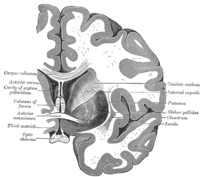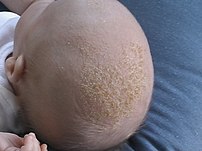Definition: Seborrhea (say: seb-uh-ree-uh) is a common skin problem. It causes a red, itchy rash and white scales. When it affects the scalp, it is called “dandruff.” It can be on parts of the face as well, including the folds around the nose and behind the ears, the forehead, and the eyebrows and eyelids. On the body, seborrhea often occurs in the middle part of the chest, around the navel and in the skin folds under the arm, below the breasts and in the groin and buttocks area.
Seborrhoeic eczema (also Seborrheic dermatitis AmE, seborrhea) is a skin disorder affecting the scalp, face, and trunk causing scaly, flaky, itchy, red skin. It particularly affects the sebum-gland rich areas of skin.
click to see the pictures…..(01)...…(1)..……..(2).…..…(3)....………………….
Who gets seborrhea?
Infants may get seborrhea. It’s known as “cradle cap.” Cradle cap goes away after about 6 months. It may also affect the diaper area and look like a diaper rash.
Seborrhea also affects adults and elderly persons, and is more common in men than in women. Seborrhea occurs more frequently in persons with oily skin.
It affects 3 percent of the general population. It occurs more commonly in older people who are bedridden or have neurologic conditions such as Parkinson’s disease. Seborrhea also affects almost 85 percent of people with AIDS.
Causes:The cause of seborrheic dermatitis is not fully understood, although many factors have been implicated.. It is likely that a number of factors, such as hormones and stress, can cause it.
The widely present yeast, Malassezia furfur (formerly known as Pityrosporum ovale), is involved, as well as genetic, environmental, hormonal, and immune-system factors. A theory that seborrhoeic dermatitis is an inflammatory response to the yeast has not been proven. Those afflicted with seborrhoeic dermatitis have an unfavourable epidermic response to the infection, with the skin becoming inflamed and flaking.
Acute form of seborrhoeic dermatitis on scalpIn children, excessive vitamin A intake can cause seborrhoeic dermatitis. Lack of biotin, pyridoxine (vitamin B6) and riboflavin (vitamin B2) may also be a cause.
It is a chronic inflammatory skin disorder that affects the areas of the head and trunk that have sebaceous glands. A type of yeast that has an affinity for these glands called Pityrosporum ovale may be the cause, but this has not been proven yet. It is believed that the build-up of yeast in these glands irritates the skin causing redness and flaking.
Seborrhea is more common in men than women and affects 3 percent of the general population. It occurs more commonly in older people who are bedridden or have neurologic conditions such as Parkinson’s disease. Seborrhea also affects almost 85 percent of people with AIDS.
Diagnosis:
Clinical Manifestations
Seborrheic dermatitis typically affects areas of the skin where sebaceous glands appear in high frequency and are most active. The distribution is classically symmetric, and common sites of involvement are the hairy areas of the head, including the scalp , the scalp margin , eyebrows, eyelashes, mustache and beard. Other common sites are the forehead , the nasolabial folds , the external ear canals and the postauricular creases. Seborrhea of the trunk may appear in the presternal area and in the body folds, including the axillae, navel, groin, and in the inframammary and anogenital areas. Figure 7 illustrates the typically symmetric distribution of seborrheic dermatitis.
More severe seborrheic dermatitis is characterized by erythematous plaques frequently associated with powdery or greasy scale in the scalp (Figure 8), behind the ears (Figure 9) and elsewhere in the distribution described above. Besides an itchy scalp, patients may complain of a burning sensation in facial areas affected by seborrhea. Seborrhea frequently becomes apparent when men grow mustaches or beards and disappears when the facial hair is removed. If left untreated, the scale may become thick, yellow and greasy and, occasionally, secondary bacterial infection may occur.
Seborrheic dermatitis is more common in men than in women, probably because sebaceous gland activity is under androgen control. Seborrhea usually first appears in persons in their teens and twenties and generally follows a waxing/waning course throughout adulthood.
UV-A and UV-B light inhibit the growth of P. ovale,9 and many patients report improvement in seborrhea during summer.
Treatment:
Soaps and detergents such as sodium laureth sulfate may precipitate a flare-up, as they strip moisture from the top layers of the skin, and the drying property of these can cause flare-ups and may worsen the condition. Accordingly a suitable alternative should be used instead.
Among dermatologist recommended treatments are shampoos containing coal tar, ciclopiroxolamine, ketoconazole, selenium sulfide, or zinc pyrithione. For severe disease, keratolytics such as salicylic acid or coal tar preparations may be used to remove dense scale. Topical terbinafine solution (1%) has also been shown to be effective in the treatment of scalp seborrhoea, as may lotions containing alpha hydroxy acids or corticosteroids (such as fluocinolone acetonide). Pimecrolimus topical lotion is also sometimes prescribed.
Chronic treatment with topical corticosteroids may lead to permanent skin changes, such as atrophy and telangiectasia.
UV-A and UV-B light inhibit the growth of M. furfur, although caution should be taken to avoid sun damage.
According to the American Academy of Family Physicians(AAFP), one treatment that has proven successful, especially when steroid topicals and shampoos aren’t working, and the patient continues to suffer from rapid hair loss and rashes, has been low doses(10mg-30mg daily) of the perscription drug Accutane,(Isotretinoin). The exact mechanism isn’t known, but it is thought to work by reducing sebum, which plays an important role in seborrhoeic dermatitis. Patients should be evaluated monthly, while examing the proper liver functions when putting a patient on accutane therapy. Special screening should be in place for women patients, because of the risk of birth defects. This therapy can last, when the condition is chronic and the isotretinoin does is low, for years. But, patients should be given a one to two month break off this particular therapy every 6 months to see if the condition still is affecting the patient
Adults who have seborrhea usually experience a waxing and waning course. In other words it can’t be “cured”. The good news is with proper maintenance, seborrhea can be controlled. Furthermore, most of the treatments can be found over-the-counter.
Treatment will help keep seborrhea under control. It’s important to keep your body clean.
Dandruff Shampoo
If you have dandruff, use medicated shampoos.
When using dandruff shampoo, first wet your hair. Rub some shampoo into your scalp and hair. Leave the shampoo on your scalp and hair for at least 5 minutes. Then rinse it out. Use the dandruff shampoo every day until your dandruff goes away. Then use the medicated shampoo 2 or 3 times a week to keep dandruff away. Having dandruff does not mean that your scalp is too dry! Dandruff comes because you need to wash your hair more often.
Medicated Shampoos should always be used.For black persons, daily shampooing may not be needed. Ask your doctor about a special steroid preparation in oil that can be used on the scalp like a pomade. Or you can use a steroid-containing shampoo.
Adults who have seborrhea usually experience a waxing and waning course. In other words it can’t be “cured”. The good news is with proper maintenance, seborrhea can be controlled. Furthermore, most of the treatments can be found over-the-counter.
Proper hygiene plays an important role in treatment. Frequent washing with soap gets rid of the oils in the affected areas and improves symptoms. Sunlight inhibits the growth of the yeast; therefore exposure of affected areas to sun is helpful, although caution should be exercised to avoid sun damage. The main medical treatments are antifungal shampoos and topical.
Cradle Cap:
Cradle cap in infants also gets better with daily shampooing. First try a mild, nonmedicated baby shampoo. If that doesn’t work, try an a dandruff shampoo. If the patch of cradle cap is large and thick, first try softening it by rubbing on warm mineral oil. Next, gently brush with a baby hairbrush. Then use shampoo.
Seborrhea Shampoos
There are several good antifungal shampoos on the market that can be purchased without a prescription. The main shampoos are selenium sulfide found in Selsun, pyrithione zinc found inHead & Shouldersulders and Sebulon, coal tar found in Sebutone and Tegrin, and finally ketoconazole found in Nizoral.
All of these shampoos have a medicated smell. The way to use them is to shampoo and leave on for at least 10 minutes then rinse off. The shampoos can be used on the face and other parts of the body as a lotion with the same instructions as long as precaution is used around the eyes. Do this daily until the redness and flaking is controlled then use 2-3 times a week as needed to keep symptoms from returning.
Topical Steroids For Seborrhea
Topical steroids reduce the inflammatory response and help control itching. You can buy hydrocortisone cream 1% over-the-counter, and it’s safe to use on the face. Apply twice a day to the affected area until the redness resolves. Save the hydrocortisone for flare-ups and use the antifungal shampoo for maintenance because long-term steroid use can cause side effects like acne and thinning of the skin.
Herbal Treatment:The World Health Organization mentions Aloe vera gel as a yet to be scientifically proven traditional medicine treatment for Seborrhoeic dermatitis.
*Arctium lappa (Burdock) oil
*Chelidonium majus (Celandine)
*Glycyrrhiza glabra (Licorice)
*Melaleuca (Tea tree) species
*Plantago (Plantain) species
*Symphytum officinale (Comfrey)
*Zingiber officinale (Ginger) root juice
*Ledebouriella Seseloides (Fang Feng)
*Smilax China (Smilax china)
*Trichosanthes Kirilowii (Snakegourd)
*Glycyrrhiza Uralensis
*Coptis Chinensis (Chinese goldthread)
*Phellodendron Amurense (Huang Bai)
*Sophora Flavescens
*Centella Asiatica (Gotu Kola)
*Evening primrose,
*dandelion root
*red clover Norwegian kelp
* berberine (from barberry, Oregon grape root or goldenseal).
Quik Tip: Evening primrose – anti-inflammatory herb of the first magnitude; it helps your
body balance itself hormonally, too.
Click to learn more about Seborrheic Dermatitis
Disclaimer: This information is not meant to be a substitute for professional medical advise or help. It is always best to consult with a Physician about serious health concerns. This information is in no way intended to diagnose or prescribe remedies.This is purely for educational purpose.
Resources:
http://en.wikipedia.org/wiki/Seborrheic_dermatitis
http://www.herbnews.org/seborrheadone.htm
http://dermatology.about.com/cs/seborrhea/a/sebderm.htm
http://www.aafp.org/afp/20000501/2703.html
http://en.wikipedia.org/wiki/Taraxacum
 Image via Wikipedia
Image via Wikipedia ![Reblog this post [with Zemanta]](https://i0.wp.com/img.zemanta.com/reblog_e.png?w=580)

 .
.
























